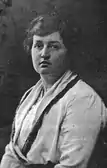Ethel Froud
Ethel Elizabeth Froud (11 April 1880 – 21 May 1941) was a British trade unionist and feminist born at The Willows, Loose, Maidstone, Kent.[1] She helped create the National Union of Women Teachers as a British feminist autonomous union.
Ethel Elizabeth Froud | |
|---|---|
 | |
| Born | 11 April 1880 |
| Died | 21 May 1941 |
| Nationality | British |
| Occupation(s) | Teacher, feminist, trade unionist |
| Organizations |
|
Early life
She was the daughter of George Christopher Froud (a butcher) and Frances Danells, his wife. Although nothing is known of her early education, she became a teacher in the West Ham borough of east London.[1]
Union activity

As a member of the National Union of Teachers (NUT), she campaigned to create a franchise of women within the organization both locally and nationally without success. She joined the Women Teachers' Franchise Union and was a speaker and member of its committee for two years from 1915 to 1917. She also joined the National Federation of Women Teachers inside the NUT and became honorary secretary in 1913. She took over this position from Joseph Tate. She resigned from teaching in 1917 to become the first full-time paid secretary of the federation. She helped created the NUWT as a break-away group from the NUT as a feminist autonomous union.[2] She was the first General Secretary of the National Union of Women Teachers (NUWT) from 1917-1940.[2]
Suffragette
She joined the Women's Social and Political Union (WSPU) as a militant suffragist and member of the fife and drum band, whose drum major was Mary Leigh. She spoke at suffrage meetings. At one point, she was protected from a mob at a railway station by being locked in a waiting room by the railway officials. She argued for equal pay at Trafalgar Square and at country-wide meetings. She was also an organizer and unifier within the NUWT, and often pulled together campaigns with other feminist groups, such as the Open Door Council and the Six Point Group in the 1920s.[2]
Politics
To defend her position that women should take part in public affairs, she ran for St Pancras Borough Council on the Labour Party platform in November 1925, but was unsuccessful.[2] Her campaign slogan was 'deeds not words', also the slogan of the WSPU.[2][3]
Death and legacy
Froud never married and was quoted as saying 'we can't have it said that we celibates are only some fraction of a human being'. She died on 21 May 1941 at her new house "Rhondhurst" in Saltdean in Sussex. She had named the house after Lady Rhondda and Emily Pankhurst the year before.[4] In 1990 Froud was chosen with three others, Agnes Dawson, Emily Phipps and headteacher Theodora Bonwick, to be featured in Hilda Kean's book, 'Deeds Not Words: The Lives of Suffragette Teachers'.[5] Her belief system was summarized by a stained glass inscription in her office at NUWT headquarters that read, 'The dreams of those that labour are the only ones that ever come true.'[2]
References
- Lisa Kasmer (16 January 2012). Novel Histories: British Women Writing History, 1760-1830. Fairleigh Dickinson. p. 45. ISBN 978-1-61147-496-1.
- Kean, Hilda (2004). "Ethel Froud". Oxford Dictionary of National Biography (online ed.). Oxford University Press. doi:10.1093/ref:odnb/48575. Retrieved 9 June 2017. (Subscription or UK public library membership required.)
- Alison., Oram (1996). Women teachers and feminist politics, 1900-39. Manchester University Press. p. 198. ISBN 9780719027598. OCLC 32969703.
- "Froud, Ethel Elizabeth (1880–1941), feminist and trade unionist". Oxford Dictionary of National Biography (online ed.). Oxford University Press. 2004. doi:10.1093/ref:odnb/48575. ISBN 978-0-19-861412-8. Retrieved 2 January 2021. (Subscription or UK public library membership required.)
- Smith, Hilda L.; Kean, Hilda (1992). "Deeds Not Words: The Lives of Suffragette Teachers". History of Education Quarterly. 32 (4): 551. doi:10.2307/368975. ISSN 0018-2680. JSTOR 368975.
Further reading
- Kean, Hilda (1990). Deeds not words : the lives of suffragette teachers. Pluto Press. ISBN 9780745304137. OCLC 21080844.